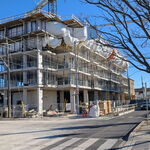44 North
Senior Member
The route may be salvageable, but is it desireable? I feel like the extension will more likely go as far on Sheppard as possible before turning south to meet BD. Which I guess would be a clever way of them to get that last part of the BD that was cut....
Well the area is kinda a dog's breakfast in terms of planning/servicing, which I guess is par for the course when plonking a CBD in a industrial/warehouse area. But keeping the line within the SC planning district as much as possible seems like there's benefit. I'd say not doing this was one of the drawbacks of SELRT. Now I don't really 'support' this or a Line 4 extension in the conventional sense. But if it does become a priority again, which seems to be gaining momentum, I think cutting the costs considerably has its benefits.





